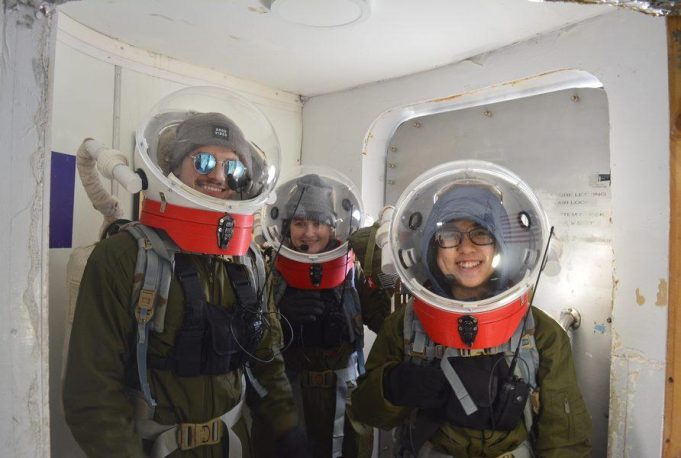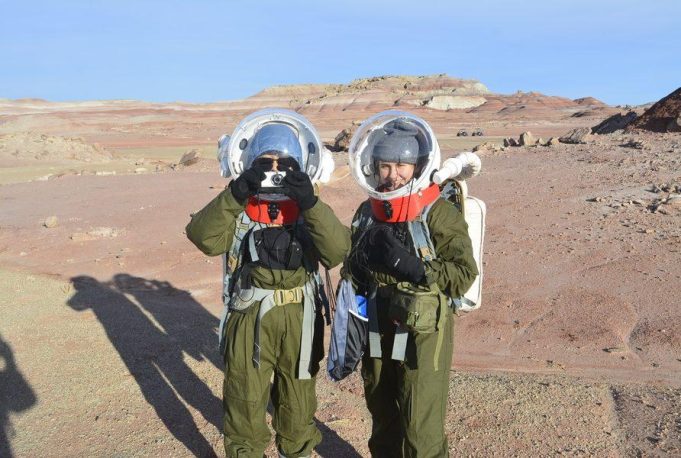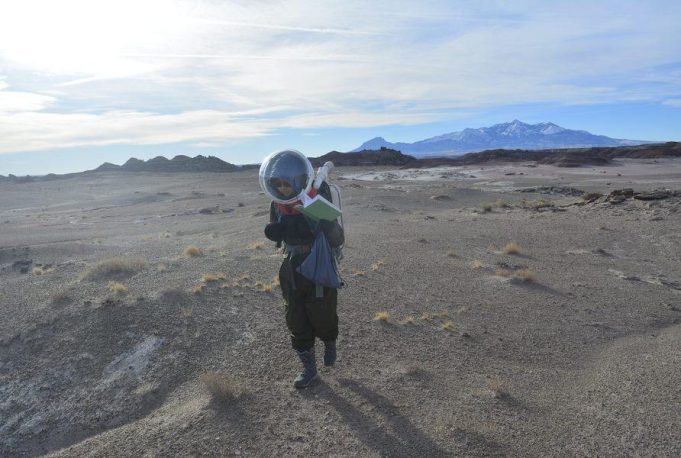Life on Mars, together
Earlier this year, Madelyn Hoying, a PhD student in the Harvard-MIT Program in Health Sciences and Technology, and Wing Lam (Nicole) Chan, an MIT senior in aeronautics and astronautics, were part of Crew 290 at the Mars Desert Research Station (MDRS), the largest and longest-running Mars analog facility in the world. Their six-person crew completed a two-week simulation under the name Project MADMEN (Martian Analysis and Detection of Microbial Environments) — an analog of potential Martian search-for-life missions.
The mission evolved from Hoying’s NASA Revolutionary Aerospace Systems Concepts – Academic Linkage (NASA RASC-AL) challenge submission, Project ALIEN, during her time as an undergraduate student at Duquesne University. After the challenge concluded, she and her colleagues refined the mission concept and created a test plan that could be conducted in a Mars-analog environment.
Hoying served as the crew’s commander and health and safety officer, and Chan as the crew’s journalist, documenting daily activities and how the crew experienced life on Mars. The other members of Crew 290 featured three from the original project: Hoying, Rebecca McCallin from Duquesne University, and Benjamin Kazimer from MIT Lincoln Laboratory. Chan, Anja Sheppard from the University of Michigan, and Anna Tretiakova from Boston University joined the team in the next phase. Hoying and Chan had worked together once before in 2022 in another RASC-AL competition.
“I was initially a bit skeptical of spending two weeks in the middle of nowhere and simply being tasked with writing about what happens every day,” says Chan. “What happens on extravehicular activities (EVAs)? How and where do we live every day? What will we be eating? These doubts all went away with the adrenaline and curiosity of seeing the Martian-esque landscape and especially after putting on the EVA helmet for the first time. It truly felt like I was living on Mars and I very quickly immersed myself in the mission.”
A unique leadership opportunity
Hoying has participated in other analog missions through MIT’s RASC-AL challenge submissions, specifically 2023’s Pale Red Dot. “I have led an analog mission in the past with [MIT AeroAstro colleague] George Lordos. We led a total crew of 11 in a dual-site mission architecture, where George led one habitat and I led the other. Pale Red Dot and Project MADMEN emphasized different features of a Martian mission, so certain aspects of this, like the extravehicular activity procedures and reporting requirements for mission support, were different.”
As commander, Hoying managed logistics, including balancing the scientific objectives of the multiple projects the crew set out to complete. “The two field experiments were soil collection for Project MADMEN and field operation of REMI, the ground-penetrating radar robot. Sometimes this led to competing requirements for EVAs, as REMI’s mass would reduce the distance that our rovers could cover before running out of battery and therefore limit the terrain types that could be reached for soil collection.”
Hoying’s main focus was balancing the crew’s requirements for data with safety, including such considerations as who had recently been on EVA, who needed a break from carrying the heavy EVA suits, how far the team could safely travel, and how the weather impacted different areas. “The decisions for what the science goals of an EVA were, who would go on each EVA, and where they would be to collect from came down to me. Ultimately, we were able to balance all of these and satisfy the collection requirements of both field projects, even with last-minute changes due to things like weather.”
The crew makes the mission
Project MADMEN involved conducting onsite field tests of geological samples and robotic experiments for landing site selection. But the success of the mission hinged on more than just in-lab results. Hosting the mission at MDRS allowed the MADMEN crew to gain valuable insights on how individuals and teams might actually experience life on Mars, psychologically and socially.
“We had a great crew, and as a result we had a great mission,” says Hoying. She managed the psychosocial aspect of the mission using daily questionnaires, studying the effects of contingency and emergency scenarios on metrics like quality of life.
The main living quarters for the crew is a two-story, 8-meter diameter cylinder called the “Hab.” The lower deck comprises the EVA prep room, an airlock, bathroom facilities, and a tunnel to the other structures. The upper deck houses the living quarters, including a kitchen and bunks. The close quarters only served to solidify the crew’s enthusiasm for the mission and support of each other.
“We shared almost every meal together and used the time to bond and talk about our interests. We often ended the day with social activities, whether it be talking about our backgrounds or future plans, playing games, or stargazing,” says Chan. “The most challenging part for me personally was stepping out of my comfort zone. Prior to this mission, I have not lived communally or camped before. It took me a bit to get used to living in close quarters with other people and balancing chores and tasks. I soon got used to the routine and enjoyed trying things for the first time, which made my experience a lot more rewarding, too.”
By day (or “Sol”) 3, the crew had assigned nicknames to each other in a call-sign ceremony. “It’s a tradition in other field experiences I’ve been a part of, and I wanted to carry that through for this crew. Assigning these was a night full of storytelling, laughing, and new memories, and we all agreed that the reasoning behind each nickname assignment would remain between the crew,” says Hoying (“Melon”); Chan’s call sign was “PODO.”
Crew 290’s Martian journals close with a reflection from Chan on their out-of-this-world experience: “As we get to work tonight, we reminisce about our time here on Mars, from the first time setting foot in the station to the first time suiting up for EVAs. We’re all so grateful to be here and have learned a lot about what it takes to be a Martian during the past two weeks.” Read all of Chan’s journal updates here.
The mission was primarily sponsored by Duquesne University and the Pennsylvania Space Grant Consortium, with some travel support provided by the Massachusetts Space Grant Consortium.





